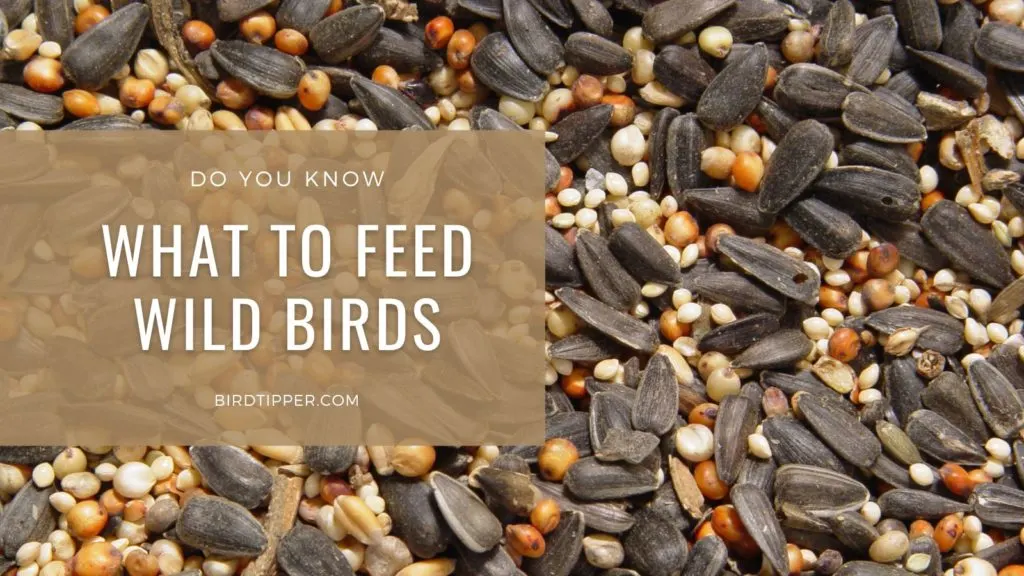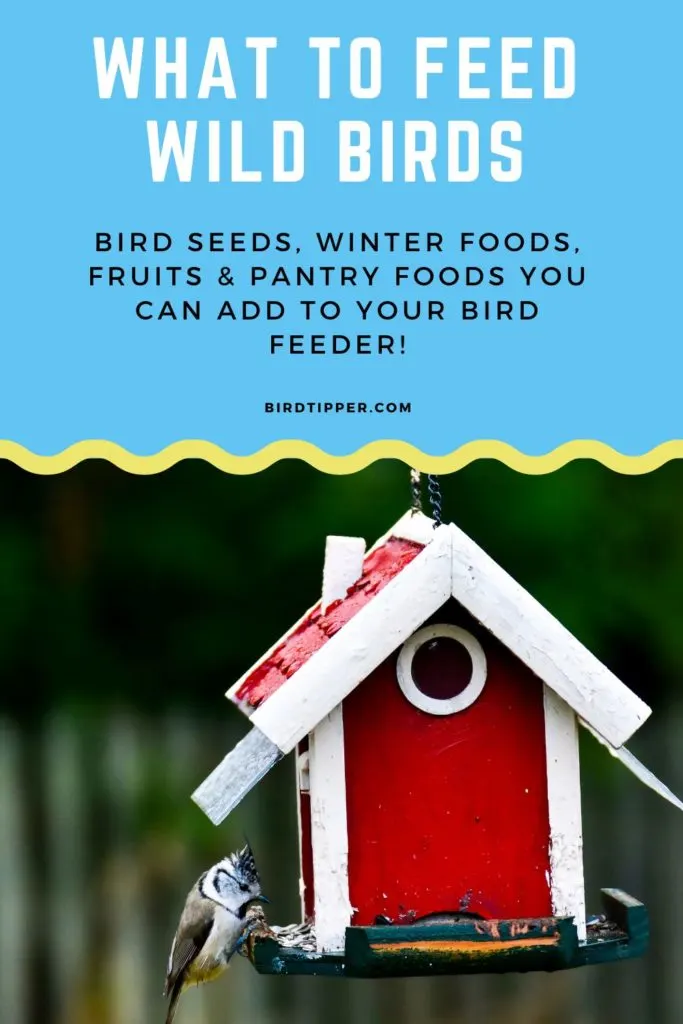Feeding birds is a great way to draw birds close to your home for easy observation. As birds learn that your yard is a source of food, you’ll reliably see birds at your feeders. Are you wondering what to feed wild birds? You’ve got a big selection of foods to choose from including everyday diets from seeds to suet to occasional treats from your kitchen.

Everyday Foods
A look around any grocery store will show you the wide array of bird foods available for wild birds. Your selection depends on your budget as well as on the birds you are hoping to attract to your feeder.
Wondering how to tell which of these seeds are in the bird feed you are buying? Like dog and cat food, bird food follows labeling requirements from the Association of American Feed Control Officials (AAFCO). On the back of the bag, you’ll find a breakdown of the bag contents; the seed listed FIRST is that which makes up the majority of the bag. As you continue down the list, the percentage decreases.
- Sunflower Seeds. The number one choice for your bird feeder is going to be sunflower seeds. They’re sold in several varieties:
- Black oil sunflower seeds. These seeds will draw the most birds. These are slightly smaller than the sunflower seeds you might have munched on.
- Striped sunflower seeds. The striped sunflower seeds–like those sold for human consumption–don’t attract as many birds as the black oil variety but are popular in mixes.
- Sunflower chips and hearts. These are shelled sunflower seeds–all meat and no mess. Unfortunately they are pricier than the varieties with shells but they do create much less mess beneath your bird feeder and thus attract fewer mice and other animals.
- Safflower Seeds. These white seeds are slightly smaller than a black sunflower seed. Squirrels, grackles, blue jays and starlings aren’t crazy about them so they may be a good choice if they’re crowding out other birds. Birds that like safflower seeds include cardinals, titmice, chickadees and more.
- Nyger or Thistle Seed. These tiny seeds are pricey and can be fed in their own feeder with little holes. This food is a favorite with goldfinches.
- Millet. This little seed is seen often in mixes. There are two kinds of millet found in birdseed–but birds have their definite favorite!
- White Proso Millet: Of the millet options, the white millet seeds are the favorite of most birds because it is a little sweeter than the red millet.
- Red Millet. Not a favorite of most birds, this is often added to birdseed mixes.
- Milo. Milo is the least favorite of most birds–most of this seed will be kicked out of the feeder. However, you can feed it on the ground to some ground feeding birds like jays and quail.
- Corn. Whole corn and cracked corn are sold for birds; cracked corn is preferred by most birds. Birds like pigeons, grackles, House sparrows and starlings will eat whole corn. Many bird lovers have a separate feeder with corn to help draw “bully birds” away from their other feeders so smaller birds can eat.
- Rapeseed. Like milo, rapeseed is used as a filler and isn’t liked by most birds; The Cornell Lab notes that quails, doves, finches and juncos will eat rapeseed.
- Canary seed. Save the canary seed for the canaries; most wild birds will pass on this seed that is mostly used as a filler.
- Peanuts. Shelled peanuts are part of many mixes and can be served as a treat, too. (Don’t serve salted peanuts.) You can also serve peanuts in the shell to large birds such as jays. Squirrels love peanuts so we keep a small platform feeder away from the bird feeder to keep the squirrels busy.
Additional Foods for Winter
- Mealworms. Mealworms are the larvae of darkling beetle–and almost a superfood for birds in terms of protein and vitamins. You can purchase dried mealworms where you buy birdseed or purchase live mealworms and raise them as live food for birds.
- Suet. Suet, the beef fat found around the kidneys, is sold in blocks, logs and balls with birdseed, and you’ll also find many homemade recipes mixed with seeds. Suet is best for cold weather months; while it’s a great source of calories for birds, it does melt in hot weather.
Fruits
Many birds love fruits–and fruit can be a special draw during the winter months when birds won’t find any juicy morsels on the trees. Here’s a list of some common fruits you can pick up at your grocery store to enjoy adding to your birdfeeder.
Be sure to check out our list of foods NOT to feed birds as well! While you can feed any of these fruits, you won’t want to feed apple seeds, cherry pits and other potentially dangerous portions of the fruit.
You’ll want to slice or halve fruits, especially for the smaller birds to enjoy. Throw away peach pits, apple seeds, cherry pits and stones; these should not be eaten by birds.
- Apples
- Bananas
- Blackberries
- Blueberries
- Cranberries
- Currants
- Grapefruit
- Grapes (if you serve grapes, be sure to do that in an area your dog does not have access to, if you have a dog)
- Melons
- Oranges
- Peaches
- Pears
- Plums
- Pumpkin
- Raspberries
- Strawberries
- Tangerines
- Watermelon
From Your Pantry
Are you out of birdseed–or just looking to provide some variety in the bird feeder? These pantry foods can be shared with birds:
- Cheese. Hard cheeses are a welcome treat.
- Cooked pasta. If you have leftover pasta with a sauce, just rinse off the sauce before feeding.
- Roasted pumpkin seeds. Just pop them in the oven; don’t add any seasonings.
- Peanut butter. Birds LOVE peanut butter; you can use it to create your own suet balls.
- Jelly. Orioles especially love jelly (especially grape); to serve, just put out a spoonful on a jar lid.
- Raisins. Soak raisins so the little birds can enjoy them, and only serve plain raisins, never ones coated with chocolate or yogurt.
- Shelled peanuts. You can purchase peanuts in the shell for your squirrel feeder but shelled peanuts are best for birds. Don’t feed salted peanuts or peanuts with any seasonings or toppings. IMPORTANT: Don’t feed shelled peanuts during nesting season when parents make take peanuts back to the nest and choke a nestling.
- Chia seeds. Chia seeds can be served raw at your feeder, adding it to your birdseed mix or including it in a suet recipe.
- Cereal. Leftover cereals can be served in your bird feeder.
- Uncooked porridge oats or oatmeal. You’ll want to be sure to feed only the UNcooked porridge because the gluten in the cooked foods can harden around the bird’s beak and be dangerous.
- Dog food and cat food. Both canned foods and dry foods can make nutritious bird food in moderation. If you’re serving large kibble, soak it first (or run it through the food processor to chop it for smaller birds). Pet food will draw predators and rodents, however, so only put out what you think the birds will eat that day.
- Cooked rice.
- Bread and baked goods. You don’t want to offer bread and baked goods exclusively because they don’t contain the nutrients needed by the birds, but bits of leftover bread are fine to add to your feeder. During nesting season, be sure to tear the bread into small bits so parents feeding nestlings won’t risk choking the young.
- Potatoes. Baked or mashed potatoes–including sweet potatoes–are loved by many birds.
- Cooked beans. Never serve dry beans but cooked beans are a good source of nutrition.
Pin it to remember What to Feed Wild Birds

